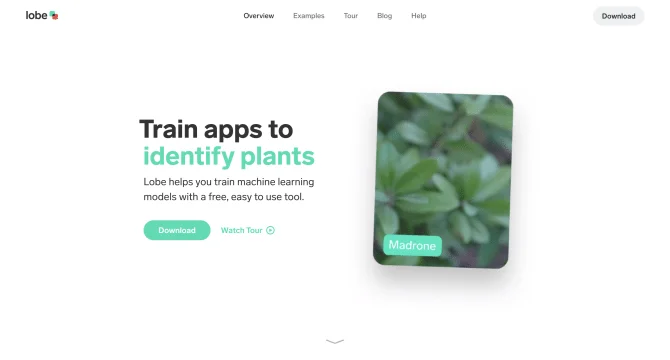Introduction
Lobe is a user-friendly application developed by Microsoft that simplifies the process of creating and training custom machine learning models. It offers a visual interface which makes AI development accessible to both beginners and professionals without the need for extensive coding knowledge. Users can train models for tasks such as image classification, object detection, and data classification. Lobe supports various input types including images, audio, and sensor data, and allows models to be exported to CoreML, TensorFlow, and potentially Windows ML. The tool also provides a feedback mechanism to improve model accuracy and can be integrated into applications for further deployment.
background
Lobe was acquired by Microsoft to democratize AI development, making it easier for non-engineers to participate in AI model creation. Since its acquisition, Lobe has continued to operate as an independent service while leveraging Microsoft's AI research and development capabilities.
Features of Lobe
Visual Programming Interface
A no-code interface that simplifies the creation and training of AI models.
Model Training
Supports training models using various data inputs with automatic and manual annotation options.
Model Export
Ability to export trained models to CoreML, TensorFlow, and potentially other platforms.
Feedback System
Users can provide feedback to improve the accuracy of the models.
Integration
Models can be integrated into applications for deployment on various platforms.
How to use Lobe?
To use Lobe, start by downloading the application from its official website. Create a new project and import your data. Lobe will assist with automatic annotation or allow manual labeling. Choose a model architecture and begin training. Once trained, evaluate and refine your model using the feedback system. Finally, export the model for integration into your applications.
Innovative Features of Lobe
Lobe's main innovation lies in its ability to abstract the complexities of AI model development into a visual, no-code interface, making AI accessible to a broader audience.
FAQ about Lobe
- How do I install Lobe?
- Download Lobe from its official website and follow the installation instructions.
- Do I need to write code to use Lobe?
- No, Lobe's visual interface eliminates the need for coding.
- What types of models can Lobe train?
- Lobe can train various models including image classifiers and object detectors.
- Can I export my model for use in other applications?
- Yes, models can be exported to CoreML, TensorFlow, and potentially other platforms.
- What support is available for Lobe users?
- Lobe provides customer support via email and has an active community on Reddit.
Usage Scenarios of Lobe
Image Classification
Use Lobe to train models that can classify images into different categories.
Object Detection
Train models to detect and recognize objects within images.
Data Classification
Utilize Lobe for classifying structured data.
Application Integration
Integrate trained models into custom applications for AI-powered functionalities.
User Feedback
Lobe's visual interface has been praised for its intuitive design, making the complex process of AI model training approachable for users without a background in coding.
Users have reported that integrating Lobe-trained models into their applications is straightforward, thanks to the export options provided.
Feedback from beginners indicates that Lobe significantly reduces the learning curve associated with AI development.
Professionals in the field appreciate Lobe's ability to quickly prototype AI models, streamlining the initial stages of more complex projects.
others
Lobe stands out in the AI development landscape by offering a seamless experience from model training to deployment. Its integration with Microsoft's suite of tools post-acquisition opens up possibilities for users to leverage advanced AI capabilities with ease.
Useful Links
Below are the product-related links, I hope they are helpful to you.
